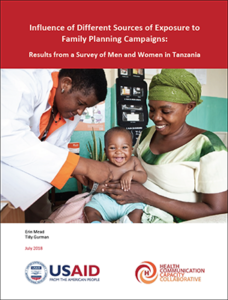Influence of Different Sources of Exposure to Family Planning Campaigns, Results from a Survey of Men and Women in Tanzania
 The use of modern contraceptives is important for the health and well‐being of women and their families. In Tanzania, the contraceptive prevalence rate has remained relatively low at 27%, and the total fertility rate relatively high at 5.4 children per woman, with significant disparities in rural areas. To address this reality, seven family planning campaigns in mainland Tanzania used social and behavioral change communication to promote use of modern contraceptives, communication with a provider about family planning (provider communication), and communication with spouse or partner about family planning (spousal communication). From January to March 2014, the Health Communication Capacity Collaborative, under the Johns Hopkins Center for Communication Programs, conducted a cross-sectional study of the cumulative effect of these family planning campaigns in a sample of 4,212 adults of reproductive age (18 to 44 years) – 75% of whom were women.
The use of modern contraceptives is important for the health and well‐being of women and their families. In Tanzania, the contraceptive prevalence rate has remained relatively low at 27%, and the total fertility rate relatively high at 5.4 children per woman, with significant disparities in rural areas. To address this reality, seven family planning campaigns in mainland Tanzania used social and behavioral change communication to promote use of modern contraceptives, communication with a provider about family planning (provider communication), and communication with spouse or partner about family planning (spousal communication). From January to March 2014, the Health Communication Capacity Collaborative, under the Johns Hopkins Center for Communication Programs, conducted a cross-sectional study of the cumulative effect of these family planning campaigns in a sample of 4,212 adults of reproductive age (18 to 44 years) – 75% of whom were women.
The study examined the association between campaign exposure and family planning‐related cognitive and behavioral outcomes. The study also examined associations between specific sources of campaign exposure and outcomes. For each individual campaign, individuals answered questions as to where they had heard about or seen the campaign – with response options slightly differing by campaign.

Leave a Reply
Want to join the discussion?Feel free to contribute!